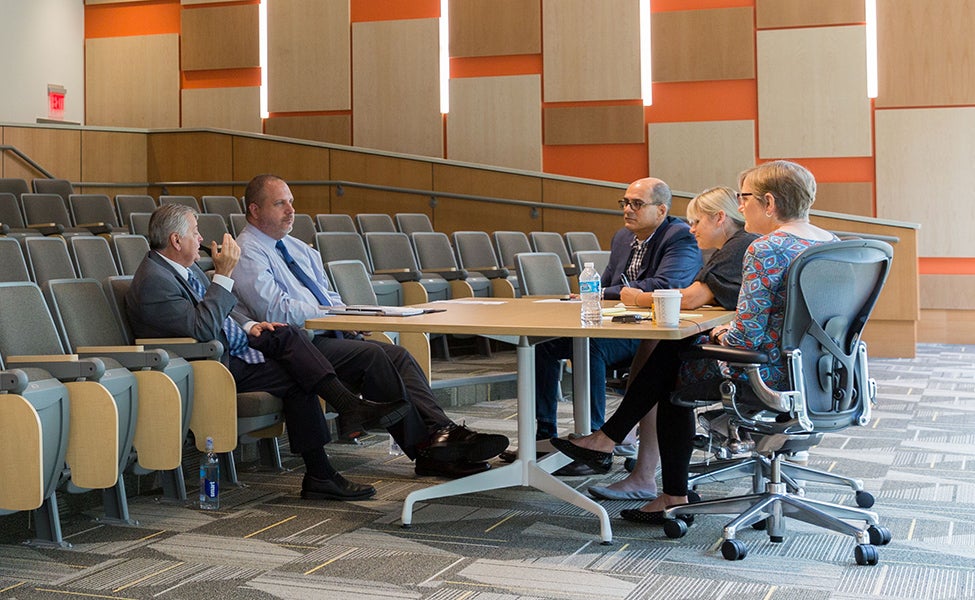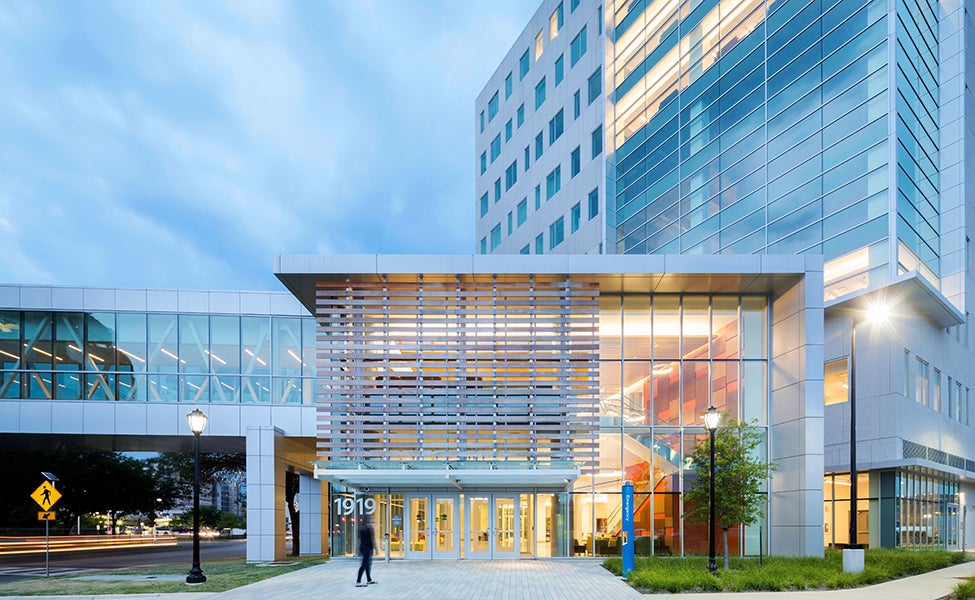
The Job Readiness Factor: Community Colleges in the Face of Changing Industries
Adaptations is an ongoing series of interviews with educators and administrators from around the world, representing diverse backgrounds, disciplines and institutions. These interviews examine how educational institutions are adapting to the ever-changing education landscape and how the built environment helps or hinders them in that effort.
This interview has been edited and condensed for clarity.

As part of this series, we sat down with Houston Community College’s (HCC) Dr. Phillip Nicotera, President of the Coleman College for Health Sciences and Jeff Gricar, Dean of Health Sciences to talk about some of the major challenges and opportunities that community colleges have in front of them, with specific focus on allied health/health science programs.
Part 1 of our interview focuses on the changing environment for community colleges in general. Dr. Nicotera notes in our interview that community colleges around the country are facing falling or stagnant enrolment. As Anthony Carnvale, director of the Center on Education and the Workforce at Georgetown University shared last year in an Inside Higher Ed article: “Nobody can see clearly how to use the post-secondary system to get a job.” Our conversation with Dr. Nicotera and Mr. Gricar sheds light on this issue and highlights some of the strategies that HCC is using to reach out to students, prepare them for the working world, and assure they have great educational experiences.
Pressing Issues for Community Colleges
Job Readiness, Market Changes and Industry Downturns
HDR: What are the biggest overall challenges facing community colleges today?
Nicotera: We’re constantly looking at the skill sets that jobs will require four, five, six years out. Some types of jobs or job responsibilities are very different at the beginning of a two- or four-year program compared to [what’s required at] the end. In health sciences, as well as other trades, changes in technology, the sophistication of equipment, and the sophistication of protocols can impact skill set requirements. It’s our job to understand and keep abreast of the changing skill sets that will help graduates get and retain a job.
In a similar vein, it can be a challenge for any community college or any college in general to meet the particular employment needs in a community like Houston that supports many industries. We have a large oil and gas industry, a large construction industry, and a large healthcare industry. Just think, we’re currently sitting in a building that is part of the Texas Medical Center, the largest medical complex in the world. Each of these industries has numerous sub-sectors. In order to adequately support their labour markets, we have to be responsive to industry change. For example, just recently we've seen a down turn in oil and gas, and so with that, the number of jobs will be reduced for a while. What exactly this does to our curriculum and degree programs is a complicated issue that has to account for industries bouncing back eventually.
College Readiness
Gricar: Another big challenge that we have specifically at community colleges and in the health sciences is with college readiness. If students aren’t ready to go to college, they might get stuck in remediation. Unfortunately, at times this can be cyclical — something they’re not able to move on from. At HCC, we’ve been working on streamlining our remediation programs, making sure that no one gets stuck in that cycle.
Nicotera: On a related note, at HCC we have a very diverse population compared to other cities around the country. For several of our students, regardless of the program, English is not their first language which adds another barrier for them. While ultimately being bilingual will be a huge benefit to them and make them highly marketable to employers, their first hurdle is to get a command of English both in terms of speaking and writing.
Enrollment Trends
Nicotera: Overall community college enrolment is down right now. Six or seven years ago, when the economy was in dire straits, a lot of people lost jobs and a lot of people went back to school. We had a huge number of students coming into colleges, especially community colleges, to get training so they could make a career change rather quickly. In my opinion, that activity artificially inflated enrolment for a number of years. Now, community colleges and even some four-year colleges are struggling a bit with enrolment. On the other hand, some specialized programs — e.g., nursing, physical therapy — don't struggle for enrolment. They actually have more students than they can admit.

Providing Superb Experiences for a Diverse Student Body
Changes in Student Expectations
HDR: How have students’ expectations changed in recent years?
Nicotera: If you look at any one of our classes, you'll see diversity in the age range. This is another common shift that many higher ed institutions are experiencing. Our younger students who are coming here right out of high school or shortly thereafter are very comfortable with an online environment. Using podcasts or other types of technology keeps them engaged. Individuals who are in their 40s and 50s tend to prefer an approach where information is delivered to them in more traditional ways. So we try to hybridize our teaching style.
One of the challenges we face with the proliferation of technology is helping students understand that they need to learn the basics first and foremost. We always make sure that the basic skill set they need is at the heart of the curriculum — giving them something that they can build off of moving forward.
HDR: Are there specific challenges you face in meeting this change in students’ expectations?
Nicotera: While we’re fortunate to have a new facility opening next year, most of our buildings are more than 10 years old, which means they weren’t designed for these new ways of learning. It becomes a challenge to try to teach differently when you have a building that was designed to teach the way we taught 10 or 15 years ago. Creating open spaces and different types of learning environments takes a certain amount of thinking outside of the box. The fiscal environment can make it even more challenging.

Equipping Faculty to Adapt to Constant Change
HDR: How do you assure that your faculty can keep up with both changes in learning preferences and changes in the industries that your programs are preparing students to enter?
Nicotera: A couple things. One — we invest in our faculty, providing a financial stipend to go to industry conferences or to get professional development on latest technologies or latest teaching methods, etc. Secondly, we also have a staffed innovation centre where we hold training sessions on new technologies. An instructional technologist is available to train faculty on any new technology and to work alongside a faculty member who wants to incorporate a new piece of technology into their curriculum. He also scans the technological landscape and brings vendors in to present new technologies.
Collaboration between Centres of Excellence
HDR: There are multiple “centres of excellence” within HCC (i.e., buildings or campuses that are dedicated to helping students excel in a specific program area) — the one you both work in being the health sciences. Is there any kind of interdisciplinary collaboration between different centres?
Gricar: There is admittedly not as much as maybe we would like. We offer some academic classes that are available to all students here in our buildings. And we might go out to one of the other campuses and offer an introductory course in pharmacy or medical assisting. But the overlap is pretty minimal at this point.
Nicotera: The centre of excellence concept is very new here, so some centres are still trying to figure out how to align themselves. But one of the things that we had been looking at over the past couple of months is collaboration in the field of robotics. Robotics is a big part of manufacturing as well as other areas such as healthcare, so we've met and we've talked about where exactly this subject fits in. How does it fit in engineering? How does it fit in healthcare? Is it a major? And if it's not a major, do we create a course on it that would be offered to all interested students? We spend time trying to determine where it might fit and where there might be potential for collaboration, because there may be some great opportunities for synergistic activities between certain centres of excellence.
Improving Student Collaboration and Study Environments
HDR: How does space help or hinder students’ ability to study or collaborate?
Nicotera: In our existing space, students hang out in the hallway wherever they can find room. Because the classrooms are built around the atrium, we've always run into issues with noise. If we want to have a student activity, we've got to try to find that small window of opportunity where we can do so and not disturb classes.
Gricar: Students hang out in the hallway where the offices are, wherever they can find space. They’re always going to do that. The new building will have a combination of an open atrium, but also some dedicated student study and collaboration space on every floor. I think students will have a much better experience overall.
Nicotera: And if you think about it, many of our students are non-traditional, or “new” traditional, and don’t hold traditional hours. They might come here early to study, because they can't do it at home. The spaces in the new building are going to give them a better place to do that than they have in the existing building.
Read part 2 of our interview that explores how HCC is preparing students for jobs in allied health.
